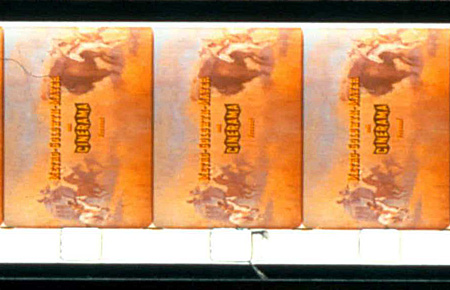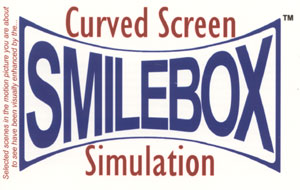Digital restoration of HOW THE WEST WAS WON
|
Read more
at in70mm.com The 70mm Newsletter |
| Written by: Rick Mitchell, Film Editor/Film Historian/Film Director © 2008, Universe rights reserved. | Date: 10.06.2008 |
 Ultimate
in home movies - Cinerama in 8mm. Ultimate
in home movies - Cinerama in 8mm.The "special screening" that ended last weekend's excellent "The Reel Thing-XX" put on for AMIA by Grover Crisp and Michael Friend was a digital presentation of Warner Home Video's digital restoration of "How The West Was Won" from original negatives. Each panel of the Cinerama negative was scanned at 2K, ultimately yielding a 6K image. A Sony 4K digital projector was used for the presentation. The last session in the "Reel Thing" program was a presentation by Bill Baggelaar of MPI, who supervised the restoration. They had two main goals: minimizing the blend lines as much as possible and correcting geometric problems caused by the nature of the three lens Cinerama camera. When focused from infinity to about 25 ft. the three 27mm lenses produce a fairly accurate representation of the 146 degree field-of-view. However, the left and right cameras are designed to toe-in when focused closer and this leads to some strange results, such as different vanishing points for each panel, that are not that obvious when projected onto the deeply curved screen, but become quite so when shown side-by-side on a flat screen. Since most of the shots in the travelogues were fairly wide, this wasn't as much of a problem as it became with the dramatic films where the directors wanted to use medium and even close shots. Photochemical technology made correcting this for non three panel presentation impossible. Though I'm not aware of any efforts to do a combined version of any of the travelogues (16mm IB prints were extracted from the center panel of "Seven Wonders of the World" (1957); I don't know if this was done for the entire film or selected sequences), according to editor Harold F. Kress in personal conversation, Technicolor did make a 35mm reduction with all three panels printed side-by-side with a 2x squeeze for editing and viewing. They later made a combined interpositive, which I'm assuming was on 65mm because both Ultra Panavision and spherical 65mm format internegatives were made, at least on "HTWWW"; I have no further information on these elements, such as their actual formatting, aspect ratio, etc. The 35mm anamorphic internegative that became the source of the general release 35mm and 16mm prints made by MGM Labs and all subsequent 35mm, 16mm, and video elements are from this source. All of these would have had the perspective flaws noted above. MPI used digital technology to get a better geometric match between the center and side panels, resulting in the kind of fish-eye effect that would have been achieved if the film had been shot on a single 105mm strand of film with a 27mm lens. While all the horizontal information was captured, this created a problem with the top and bottom of the frame. As it happened, Cinerama films were composed with extra headroom to allow for theaters whose prosceniums were lacking in height. Since the amount of perspective varied depending on the point of focus of the shot, resulting in variations in framelines, MPI decided to letterbox the image to a ratio that covered all situations, resulting in the 2.89:1 AR announced in initial publicity, the ultimate "letterbox". How does this look? On the 42 ft. screen [12,8 m, ed] of the Academy's Pickford Center Linwood Dunn Theater, it was no problem, but on a 42 inch monitor? Fortunately, the Blu-Ray disc will also have the film rendered in MPI's version of David Strohmaier and Greg Kimble's "Smilebox"®, which simulates the way the film would look from the ideal seat in a Cinerama theater. This format is quite effective on 4:3 screens and it will be interesting to learn how many fans prefer watching the film this way. The 2.89:1 ratio also contributes to the controversy over "how wide is too wide", which has been going on since the aborted Wide Film Revolution of 1930. It's the widest format used for mainstream motion picture presentation to date, wider than Ultra-Panavision (2.75:1), small format anamorphic (@2.66:1 depending on how the aperture is cut, and the recommended projection aperture for three panel Cinerama (2:59:1). Because "HTWWW" was photographed primarily with wide angle lenses, it actually does not look all that awkward, on a large screen. Fair evaluation of compositions is compromised because of the necessity of keeping the subjects within a given panel in original photography rather than composing for the entire frame. However, with apparent declining interest in seriously working in aspect ratios wider than 16:9, this issue may be moot. |
More
in 70mm reading: "How The West Was Won" in Cinerama How the West Was Won on DVD To Split or not to Split "The Alamo" Ultra Panavision Who's Rick Mitchell? |
 Because of my familiarity with the film, I was subconsciously seeing the
panel splits, but they've done such a good job of pulling the images
together that I doubt they'll be visible on smaller video displays. They
are really only noticeable when there is horizontal movement from
panel-to-panel, especially when the moving object is closer to the
camera than where it was focused. They are also noticeable in shots
where they couldn't totally correct for the geometry across the split.
One interesting instance is one of the few lateral tracking shots in the
film, the camera traveling along side a Pony Express rider. This shot
looks rather strange in Cinerama and really awkward in old combines.
Here it looks better but really emphasizes the fisheye lens effect. Because of my familiarity with the film, I was subconsciously seeing the
panel splits, but they've done such a good job of pulling the images
together that I doubt they'll be visible on smaller video displays. They
are really only noticeable when there is horizontal movement from
panel-to-panel, especially when the moving object is closer to the
camera than where it was focused. They are also noticeable in shots
where they couldn't totally correct for the geometry across the split.
One interesting instance is one of the few lateral tracking shots in the
film, the camera traveling along side a Pony Express rider. This shot
looks rather strange in Cinerama and really awkward in old combines.
Here it looks better but really emphasizes the fisheye lens effect.The only negative is the reproduction of the Ultra Panavision material. This has always been a problem since, for the original version, it had to be double duped through Kodak's 5253 Intermediate stock. Introduced in 1956 and supposedly improved over the next twenty years, it was still not deemed good enough to allow labs to stop release printing from the original cut camera negative until the introduction of 5249 CRI stock in 1968. Use of the large format 65mm negative helped, but even in original IB Cinerama prints, the image quality change was quite noticeable and was worse in the combined elements, which added an additional two generations to the material. For cost reasons, MPI did not scan from the 65mm originals, which still exist, but reduced to those scenes to 35mm VistaVision for scanning. The quality of the results varies. Ironically, the material taken from "The Alamo" and "Raintree County", and here reproduced from the three panel dupe negative, looks better. The original seven channel dub has been rechanneled to 5.1, with an enhanced low end and inconsistent placement of dialogue and effects entirely in the center channel or with their onscreen sources. It includes the overture, en'tracte, and walk out music. Though I'm not a video person, I know this is going to be very controversial when released in August, especially the non-"Smilebox"® version, and I leave that to others. |
|
|
Go: back
- top - back issues
- news index Updated 22-01-25 |
